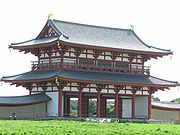
Suzakumon Gate
Encyclopedia

Fujiwara-kyo
was the Imperial capital of Japan for sixteen years, between 694 and 710. It was located in Yamato Province , having been moved from nearby Asuka. However, in the Nihon Shoki, the name Fujiwara-kyō had never been used...
(Kashihara), Heijō-kyō (Nara
Nara, Nara
is the capital city of Nara Prefecture in the Kansai region of Japan. The city occupies the northern part of Nara Prefecture, directly bordering Kyoto Prefecture...
), and later Heian-kyō
Kyoto
is a city in the central part of the island of Honshū, Japan. It has a population close to 1.5 million. Formerly the imperial capital of Japan, it is now the capital of Kyoto Prefecture, as well as a major part of the Osaka-Kobe-Kyoto metropolitan area.-History:...
(Kyoto
Kyoto
is a city in the central part of the island of Honshū, Japan. It has a population close to 1.5 million. Formerly the imperial capital of Japan, it is now the capital of Kyoto Prefecture, as well as a major part of the Osaka-Kobe-Kyoto metropolitan area.-History:...
). The placement followed the ancient Chinese palace model requirements at the time, where , the Vermilion Bird
Vermilion Bird (Chinese constellation)
The Vermilion bird is one of the Four Symbols of the Chinese constellations. According to Wu Xing, the Taoist five-elemental system, it represents the fire-element, the direction south, and the season summer correspondingly. Thus it is sometimes called the Vermilion bird of the South...
was the Guardian of the South. (See Four Symbols
Four Symbols (Chinese constellation)
The Four Symbols are four mythological creatures in the Chinese constellations. They are:*Azure Dragon of the East *Vermilion Bird of the South *White Tiger of the West *Black Tortoise of the North...
for more.)
It was said to be the site where foreign dignitaries were received by the Emperor. All of them were destroyed centuries ago along with the old imperial residences.
Nara Suzakumon
In 1993, it was decided that the gate of Nara would be reconstructed. It proved extremely difficult to work out what Suzakumon had looked like, as there were no surviving structural remnants. A conjectural model was developed, based on comparable architecture elsewhere, and the new gate was constructed from a mixture of traditional building materials (cypressCupressaceae
The Cupressaceae or cypress family is a conifer family with worldwide distribution. The family includes 27 to 30 genera , which include the junipers and redwoods, with about 130-140 species in total. They are monoecious, subdioecious or dioecious trees and shrubs from 1-116 m tall...
wood and tiles) and concrete, in order to resist earthquakes. The reconstructed gate was opened in 1998.

